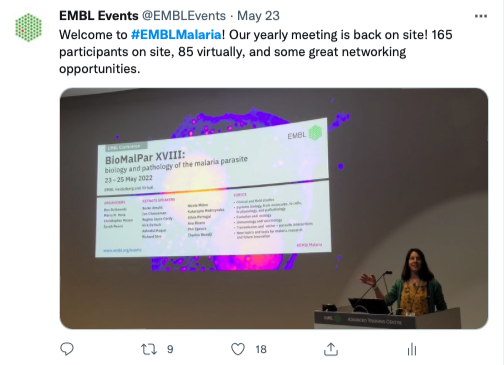Poster prizes at ‘BioMalPar XVIII: biology and pathology of the malaria parasite’ – meet the winners!
We are excited to present the 2 poster prizes winners from the EMBL Conference ‘BioMalPar XVIII: biology and pathology of the malaria parasite’, our annual event that showcases the multidisciplinary nature of malaria research with a programme that welcomes clinical malaria, epidemiological studies, immunology, and evolution and ecology.
Protection mechanism of anti-Plasmodium falciparum circumsporozoite protein human antibodies in the host tissues
Presenter: Manuela Aguirre-Botero

Abstract
The deposition of Plasmodium sporozoites in the skin is a critical event preceding liver infection and the onset of malaria symptoms. Prior studies have shown that antibodies against central repetitive region of the circumsporozoite protein (CSP) inhibit sporozoite function by limiting their motility and inducing cytotoxicity. However, how these properties translate into protection against sporozoite infection in vivo remains elusive. To address these questions, we quantified parasite neutralization in the skin and blood after passive immunization with a library of human monoclonal antibodies (hmAb) targeting the junctional, minor repeat (NVDP) and major repeat (NANP) regions of the P. falciparum CSP and showing varying levels of protection. Protection data was then correlated with in vitro neutralizing activities. Most of the hmAbs only confer potent protection after sporozoite passage through the skin. Importantly, the most efficient hmAbs are also able to neutralize sporozoites directly in the blood and liver. While the protection conferred after sporozoite inoculation in the skin correlates with cytotoxicity and inhibition of motility in vitro, intravital imaging showed sporozoites are still able to enter the bloodstream, suggesting a general loss of fitness after skin migration instead of a direct blockade in the dermis. In vitro, migration in a 3D environment but not on a 2D substrate enhanced hmAb cytotoxicity and recapitulated the protection observed after sporozoite inoculation in the skin. Remarkably, 3D cytotoxicity also correlates with protection of passively immunized mice after infection by mosquito bite. Altogether this suggests that the physical stress endured during locomotion in the skin is crucial for unfolding the protective potential of the hmAbs, causing a critical decrease in sporozoite fitness and reflected in a total loss of infectivity. Ultimately, additional ability to neutralize in the blood and liver defines the most potent hmAbs. 3D cytotoxicity assays could thus emerge as predictive tools for the screening of potent protective hmAbs for prophylactic use in humans, as well as, to assess the efficacy of new vaccine candidates targeting the P. falciparum CSP. Funding: ANR SporoStop, Institut Pasteur
Due to the confidentiality of the unpublished data, we cannot share the poster.
A genetic switch controls sex determination in Plasmodium falciparum
Presenter: Arthur Talman

Abstract
Sexual reproduction and meiotic sex are deeply rooted in the eukaryotic tree of life but mechanisms determining sex or mating types are extremely varied and only well characterised in a few model organisms. Sexual differentiation in Plasmodium is initiated when a subset of intra-erythrocytic parasites become committed to a sexual fate under the control of the master regulator of sex, AP2G. Following the initial AP2G-dependent gene expression program, sexually-committed progenitor parasites undergo a secondary cell fate decision to become either a male or a female gametocyte. After this sex determining event, male and female cells follow a distinct developmental program. Sex determination is epigenetic, with each haploid parasite capable of producing either a male or a female gametocyte in the human host. The hierarchy of events and molecular mechanisms that trigger sex determination and maintenance of sexual identity are yet to be elucidated. Here we identify male development 1 (MD1) and leverage single cell RNAseq to show that Md1 is both necessary and sufficient for male fate determination in the human malaria parasite Plasmodium falciparum. We show that Md1 has a dual function stemming from 2 separate domains: in sex determination through its N-terminus and in male development from its conserved C-terminal domain. We further identify a bistable genetic switch at the md1 locus, which is coupled with the sex determining event and ensures the male determining gene is not expressed in the female lineage. In genetically-determined systems, cell fate control can rely on the presence or absence of a sex determining loci to orchestrate specification of sex. We show that determination of sex in genetically identical cells requires a robust regulatory architecture on high level regulators of a cell’s sexual fate.
Due to the confidentiality of the unpublished data, we cannot share the poster.
Couldn’t make it to BioMalPar? Take a look at the #EMBLMalaria coverage for a glimpse of what happened at the meeting.

The EMBL Conference ‘BioMalPar XVIII: biology and pathology of the malaria parasite’ took place from 23 – 25 May 2022 at EMBL Heidelberg and virtually.